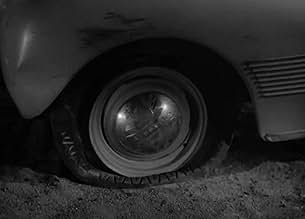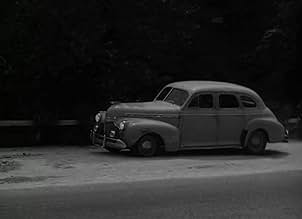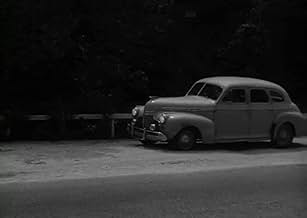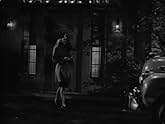IMDb RATING
6.7/10
2.4K
YOUR RATING
A mortally-wounded female gangster recounts how she and her gang revived an executed killer from the gas chamber to try to find out where he buried a fortune in cash.A mortally-wounded female gangster recounts how she and her gang revived an executed killer from the gas chamber to try to find out where he buried a fortune in cash.A mortally-wounded female gangster recounts how she and her gang revived an executed killer from the gas chamber to try to find out where he buried a fortune in cash.
Jean Gillie
- Margot Shelby
- (as Miss Jean Gillie)
Philip Van Zandt
- Tommy
- (as Phil Van Zandt)
Walden Boyle
- Chaplain
- (uncredited)
Martin Cichy
- Policeman
- (uncredited)
Tom Coleman
- Trucker at Roadside Inn
- (uncredited)
Franco Corsaro
- Kelsey
- (uncredited)
Madge Crane
- First Visitor
- (uncredited)
Dick Elliott
- Driver
- (uncredited)
Virginia Farmer
- Georgia - Margot's Maid
- (uncredited)
- Director
- Writers
- All cast & crew
- Production, box office & more at IMDbPro
Featured reviews
And makes Barbara Stanwyck and Ann Savage look like Ned(Jane?)in the first reader in the process. And, in "Decoy", femme fatality is a more apt term as all the male characters she encounters have less chance of surviving than Elisha Cook Jr. did going against Jack Palance in "Shane"...zip,nada,none,nought,zap and gone. Sheldon Leonard survives an encounter but only because she is dying when he shows up. The surprise is that she didn't take him out on the way out. Repeated viewings still figure him for no better than even at that. The taglines and blurbs on the posters and ads paint the following picture of her Margot Shelby character: "SHE TREATS MEN THE WAY THEY'VE BEEN TREATING WOMEN FOR YEARS!" Another line defines that as; "She Two-Times, Steals, Cheats, Double-Crosses...Anything To Get What She Wants...and then KISSES THEM OFF." Actually, she runs a car over Edward Norris, which was lack of good judgement on his part for hanging around with a broad known for..."kissing quick and killing quicker." She takes doctor Herbert Rudley away from Marjorie Woodworth,as she needs him to revive her just-executed in the gas chamber boy friend---no lack of plot in this one---which accounts for the only credibility gap in the film...somebody please tell me why Marjorie Woodworth wanted Herbert Rudley in the first place. Good riddance,Marjorie, you can do better although, come to think of it, you seldom did. Gillie gives Rudley a shovel, makes him dig up the buried money and then, in payment for past favors and services, shoots him dead. She had to double check to make certain as there wasn't much difference in his performance either way. Bottom line: Jean Gillie gets a wing to herself in the Femme Fatale Hall of Fame.
Given this film’s rarity (it went unseen for 30 years), I guess even self-confessed film nuts could be excused for never having heard of it – that is, until its announcement as part of Warners’ fourth “Film Noir Collection” on DVD. While some of the pairings in that 10-Movie 5-Disc Set were done without rhyme or reason – and it had seemed to me to be so here as well! – the film actually had a connection to its companion piece, CRIME WAVE (1954; which I’ve just watched a couple of days ago), via the credit on both of blacklisted scriptwriter/actor Nedrick Young (he appeared in the latter but only wrote DECOY).
Being a Monogram production, the film wears its Poverty Row status on its sleeve – with a bizarre plot (involving the re-animation of the dead: this has to be the only vintage crime outing to take the genre into the realm of sci-fi!), gritty look and second-rate cast – but which it generally manages to turn in its favor. In my review for CRIME WAVE itself, I had written how surprised I was that the film proved to be so good – this, then, came as even more of a shock (joining the ranks of such ramshackle ‘B’ noir gems as DETOUR, DILLINGER {both 1945} and GUNMAN IN THE STREETS [1950])! The film was devised as a showcase for British actress Jean Gillie by her husband, director Bernhard – however, the couple would divorce soon after and (even more sadly) Gillie herself would be dead of pneumonia in just a couple of years’ time! Still, hers is one of the most unscrupulous femme fatales ever conceived – ensnaring practically the entire male cast in her obsessive pursuit of money – and which she plays in a slightly overstated (but, under the circumstances, entirely fitting) manner.
The rest of the cast includes Edward Norris as Gillie’ crooked associate, Robert Armstrong as her ageing gangster boyfriend currently on Death Row and the only one who knows the location of a stashed cache' containing $400,000, Herbert Rudley as the small-town doctor enticed by Gillie into her unholy revivification scheme, and Sheldon Leonard as the cagey and dogged cop on their trail. Norris is somewhat stiff, while Armstrong (the original Carl Denham of “King Kong” fame) brings his typical zest to the role of love-struck and over-the-hill duped mobster – but both Rudley (bemoaning his betrayal of the code governing his profession) and Leonard (secretly enamored of Gillie himself, he’s willing to answer her plea at the moment of death to “stoop to her level”…but she just laughs in his face!) match the lady’s display of cool elegance disguising an essentially hard-boiled nature. Incidentally, Gillie’s character anticipated such celebrated noir bad girls of the ‘deadly sweet’ variety as Jane Greer in OUT OF THE PAST (1947) and Peggy Cummins (coincidentally, another British actress) in GUN CRAZY (1950) – but also Gaby Rodgers in KISS ME DEADLY (1955) in view of her similar histrionic outburst when finally laying hands on the long sought-after object of contention.
Unfortunately, it’s been revealed that the print of DECOY utilized for the DVD is slightly censored: one of the main characters is trampled no less than three times by a car which has Gillie at the wheel – however, we only get to see this once in the current version! For the record, Bernhard (whose first directorial effort this was) had been an executive at Universal – responsible for such popular ‘B’ horror outings as HORROR ISLAND and MAN-MADE MONSTER (1941; which I still haven’t managed to check out!). Finally, I’m to follow DECOY with another noir of his – the evocatively-titled BLONDE ICE (1948), via the “Special Edition” released by VCI…
Being a Monogram production, the film wears its Poverty Row status on its sleeve – with a bizarre plot (involving the re-animation of the dead: this has to be the only vintage crime outing to take the genre into the realm of sci-fi!), gritty look and second-rate cast – but which it generally manages to turn in its favor. In my review for CRIME WAVE itself, I had written how surprised I was that the film proved to be so good – this, then, came as even more of a shock (joining the ranks of such ramshackle ‘B’ noir gems as DETOUR, DILLINGER {both 1945} and GUNMAN IN THE STREETS [1950])! The film was devised as a showcase for British actress Jean Gillie by her husband, director Bernhard – however, the couple would divorce soon after and (even more sadly) Gillie herself would be dead of pneumonia in just a couple of years’ time! Still, hers is one of the most unscrupulous femme fatales ever conceived – ensnaring practically the entire male cast in her obsessive pursuit of money – and which she plays in a slightly overstated (but, under the circumstances, entirely fitting) manner.
The rest of the cast includes Edward Norris as Gillie’ crooked associate, Robert Armstrong as her ageing gangster boyfriend currently on Death Row and the only one who knows the location of a stashed cache' containing $400,000, Herbert Rudley as the small-town doctor enticed by Gillie into her unholy revivification scheme, and Sheldon Leonard as the cagey and dogged cop on their trail. Norris is somewhat stiff, while Armstrong (the original Carl Denham of “King Kong” fame) brings his typical zest to the role of love-struck and over-the-hill duped mobster – but both Rudley (bemoaning his betrayal of the code governing his profession) and Leonard (secretly enamored of Gillie himself, he’s willing to answer her plea at the moment of death to “stoop to her level”…but she just laughs in his face!) match the lady’s display of cool elegance disguising an essentially hard-boiled nature. Incidentally, Gillie’s character anticipated such celebrated noir bad girls of the ‘deadly sweet’ variety as Jane Greer in OUT OF THE PAST (1947) and Peggy Cummins (coincidentally, another British actress) in GUN CRAZY (1950) – but also Gaby Rodgers in KISS ME DEADLY (1955) in view of her similar histrionic outburst when finally laying hands on the long sought-after object of contention.
Unfortunately, it’s been revealed that the print of DECOY utilized for the DVD is slightly censored: one of the main characters is trampled no less than three times by a car which has Gillie at the wheel – however, we only get to see this once in the current version! For the record, Bernhard (whose first directorial effort this was) had been an executive at Universal – responsible for such popular ‘B’ horror outings as HORROR ISLAND and MAN-MADE MONSTER (1941; which I still haven’t managed to check out!). Finally, I’m to follow DECOY with another noir of his – the evocatively-titled BLONDE ICE (1948), via the “Special Edition” released by VCI…
I have to say that Decoy was one interesting cinematic experience. The story had a lot of holes in it and the plan that was made by the bad guys had a lot of faults in it.
But what makes this film get as high a rating from me as I give it is the presence of Jean Gillie who made only one more film after this one before dying at 33. Just like another British beauty Kay Kendall.
Gillie is one devil woman and she's got one devilish plan to $400,000.00 of stolen loot that Robert Armstrong has hidden away. She's been Armstrong's moll for years, but he's going to the gas chamber. Never mind Gillie's found a way to beat the gas chamber. But it involves getting a doctor and another hoodlum to pull it off.
The key is Dr. Herbert Rudley who supervises the executions. There's a chemical if administered within a short time that can counteract the effects of cyanide. Gillie puts on quite a campaign to vamp Rudley and soon he's just putty. Her other hoodlum boyfriend Edward Norris is amused at Rudley, but he's also thinking with his crotch.
Even Sheldon Leonard playing a cop instead of gangster for once is also not immune to Gillie when she turns it on. If some company could have bottled what Gillie had and sold it to the government it would be quite a formidable weapon.
The script isn't all that great, but Gillie and the cast of sex struck males really put this Monagram classic over.
But what makes this film get as high a rating from me as I give it is the presence of Jean Gillie who made only one more film after this one before dying at 33. Just like another British beauty Kay Kendall.
Gillie is one devil woman and she's got one devilish plan to $400,000.00 of stolen loot that Robert Armstrong has hidden away. She's been Armstrong's moll for years, but he's going to the gas chamber. Never mind Gillie's found a way to beat the gas chamber. But it involves getting a doctor and another hoodlum to pull it off.
The key is Dr. Herbert Rudley who supervises the executions. There's a chemical if administered within a short time that can counteract the effects of cyanide. Gillie puts on quite a campaign to vamp Rudley and soon he's just putty. Her other hoodlum boyfriend Edward Norris is amused at Rudley, but he's also thinking with his crotch.
Even Sheldon Leonard playing a cop instead of gangster for once is also not immune to Gillie when she turns it on. If some company could have bottled what Gillie had and sold it to the government it would be quite a formidable weapon.
The script isn't all that great, but Gillie and the cast of sex struck males really put this Monagram classic over.
(April, 2000): Just saw a rare print at the American Cinematheque Noir festival and the film knocked my socks off. As evidenced by this performance, Jean Gillie would have been one of the greats of Noir had she not died in 1949. She powers through this film, getting man after man to do her bidding, never taking no for an answer. And the obstacles that would stop a lesser character don't bother her in the least. The problem confronting her: her boyfriend is on death row. Only he knows where $400,000 from a robbery is. And she uses her feminine wiles to persuade him, and two other men, to discern the location of that dough because, *she wants that money.* Even the gas chamber doesn't slow her down ... which is where the slight sci-fi element is introduced. If this turns up on late-night video, set your VCR. You will be amazed.
When Jean-Luc Godard dedicated Breathless to Monogram Pictures, foremost in his memory must have been Decoy. It's a movie whose reputation, over the years, has grown into folklore, because it's all but impossible to view or obtain. For aficionados of film noir, it has attained the stature of a Holy Grail (or Maltese Falcon), a fabulous treasure the quest for which seems doomed to futility. It has, however, showed up at festival screenings, and now circulating, in samizdat as it were, is a subtitled copy taped from Croatian television.
While probably it can't ever live up to the inflated legend that trails in its wake, it's decidedly no disappointment. Monogram and its raffish rivals on Poverty Row shot fast and cut corners, working from fast-and-loose scripts full of implausible chunks of plot for viewers either to swallow or choke on. Usually, the results were shoddy and forgettable. But now and again enough elements came together to generate unexpected chemistry. Decoy marks one such serendipitous occasion.
The key element in this explosive reaction is Jean Gillie, an English actress whose early death in 1949 deprived cinema of one of its darkest Jezebels. Like her compatriot Peggy Cummins (Annie Laurie Starr in Gun Crazy), she makes no attempt, as Margot Shelby, to Americanize her origins; in explanation, Decoy lets her spit out her contempt for poverty in an eloquent aria about that 'dingy, dirty street' that 'runs all over the world,' and through the sooty mill town in England she came from. She vows never to go back to want, and her unquenchable greed powers the plot.
Tricked out in haut-forties snoods, stoles, muffs and dead-serious hats, Gillie cuts a swath through the various men who stand between her and the $400-grand stolen by her gangster boyfriend (Robert Armstrong. Trouble is, he's the only one who knows where it's stashed but won't tell even though he's on death row.
But her days as a high-maintenance moll have taught her a thing or two, one of them that a tincture called Methylene Blue can reverse an execution by cyanide. She works her wiles on maverick mobster Edward Norris and an idealistic doctor who does prison autopsies (Herbert Rudley), enlisting them in her gruesome scheme. They hijack the fresh corpse, en route to an 'oven job,' and, in a sequence reminiscent of Frankenstein, bring it back to life.
Still, the tight-fisted old zombie won't trust them, instead roughing out a map to the buried strongbox but keeping half (why just half?) against the prospect of this second coming's failing to take. It's a turn of events that kicks Gillie's avarice into lethal overdrive....
Though the movie wouldn't be remarkable without Gillie, it shows a fair amount of craft. From his 11 recorded directorial credits, Jack Bernhardt couldn't have been expected to contribute much, but he adds some arresting details (a sprung window shade in the doctor's office among them) and an offbeat pace. He splits the ending in two, leaving half in its proper place and opening the movie with the other, in a gas-station men's room where the shattered mirror and filthy sink outdo one another as emblems of last-ditch squalor. Police detective Sheldon Leonard figures prominently in those two segments; the rest of the movie is told in extended flashback.
There's barely a moment when Gillie isn't front and center, for which gratitude should be fulsome. She delivers a go-for-broke performance, short on nuance but long on the flamboyant gesture. She coldly guns the motor to run down one of her victims, skitters into hysterical giggles when she shoots the next, and, dying, laughs in Leonard's face after coaxing him to kiss her ('Jo Jo, just this once, come down to my level'). She's a knockout, and because of her the elusive Decoy, despite the inevitable shortcomings of its Monogram origins, can be counted a knockout, too film noir with no frills.
While probably it can't ever live up to the inflated legend that trails in its wake, it's decidedly no disappointment. Monogram and its raffish rivals on Poverty Row shot fast and cut corners, working from fast-and-loose scripts full of implausible chunks of plot for viewers either to swallow or choke on. Usually, the results were shoddy and forgettable. But now and again enough elements came together to generate unexpected chemistry. Decoy marks one such serendipitous occasion.
The key element in this explosive reaction is Jean Gillie, an English actress whose early death in 1949 deprived cinema of one of its darkest Jezebels. Like her compatriot Peggy Cummins (Annie Laurie Starr in Gun Crazy), she makes no attempt, as Margot Shelby, to Americanize her origins; in explanation, Decoy lets her spit out her contempt for poverty in an eloquent aria about that 'dingy, dirty street' that 'runs all over the world,' and through the sooty mill town in England she came from. She vows never to go back to want, and her unquenchable greed powers the plot.
Tricked out in haut-forties snoods, stoles, muffs and dead-serious hats, Gillie cuts a swath through the various men who stand between her and the $400-grand stolen by her gangster boyfriend (Robert Armstrong. Trouble is, he's the only one who knows where it's stashed but won't tell even though he's on death row.
But her days as a high-maintenance moll have taught her a thing or two, one of them that a tincture called Methylene Blue can reverse an execution by cyanide. She works her wiles on maverick mobster Edward Norris and an idealistic doctor who does prison autopsies (Herbert Rudley), enlisting them in her gruesome scheme. They hijack the fresh corpse, en route to an 'oven job,' and, in a sequence reminiscent of Frankenstein, bring it back to life.
Still, the tight-fisted old zombie won't trust them, instead roughing out a map to the buried strongbox but keeping half (why just half?) against the prospect of this second coming's failing to take. It's a turn of events that kicks Gillie's avarice into lethal overdrive....
Though the movie wouldn't be remarkable without Gillie, it shows a fair amount of craft. From his 11 recorded directorial credits, Jack Bernhardt couldn't have been expected to contribute much, but he adds some arresting details (a sprung window shade in the doctor's office among them) and an offbeat pace. He splits the ending in two, leaving half in its proper place and opening the movie with the other, in a gas-station men's room where the shattered mirror and filthy sink outdo one another as emblems of last-ditch squalor. Police detective Sheldon Leonard figures prominently in those two segments; the rest of the movie is told in extended flashback.
There's barely a moment when Gillie isn't front and center, for which gratitude should be fulsome. She delivers a go-for-broke performance, short on nuance but long on the flamboyant gesture. She coldly guns the motor to run down one of her victims, skitters into hysterical giggles when she shoots the next, and, dying, laughs in Leonard's face after coaxing him to kiss her ('Jo Jo, just this once, come down to my level'). She's a knockout, and because of her the elusive Decoy, despite the inevitable shortcomings of its Monogram origins, can be counted a knockout, too film noir with no frills.
Did you know
- TriviaMethylene blue is a real chemical compound, discovered in 1896 (by Heinrich Caro), which does indeed have the ability to counteract cyanide poisoning. This property was discovered in 1933 by Dr. Matilda Moldenhauer Brooks of San Francisco. It will not, however, restore life to those who have died from cyanide poisoning.
- GoofsWhen Joe walks into the bar, he pauses by the piano. The piano player raises his left hand off the keyboard to wave to Joe, but the piano music continues as if both his hands are still playing.
- Quotes
Sergeant Joe Portugal: Don't let that face of yours go to your head.
Margot Shelby: Or to yours?
Sergeant Joe Portugal: It wouldn't matter if did... People who use pretty faces like you use yours, don't live very long anyway.
- ConnectionsFeatured in Film Noir: Bringing Darkness to Light (2006)
- How long is Decoy?Powered by Alexa
Details
- Runtime
- 1h 16m(76 min)
- Color
- Aspect ratio
- 1.33 : 1
Contribute to this page
Suggest an edit or add missing content































